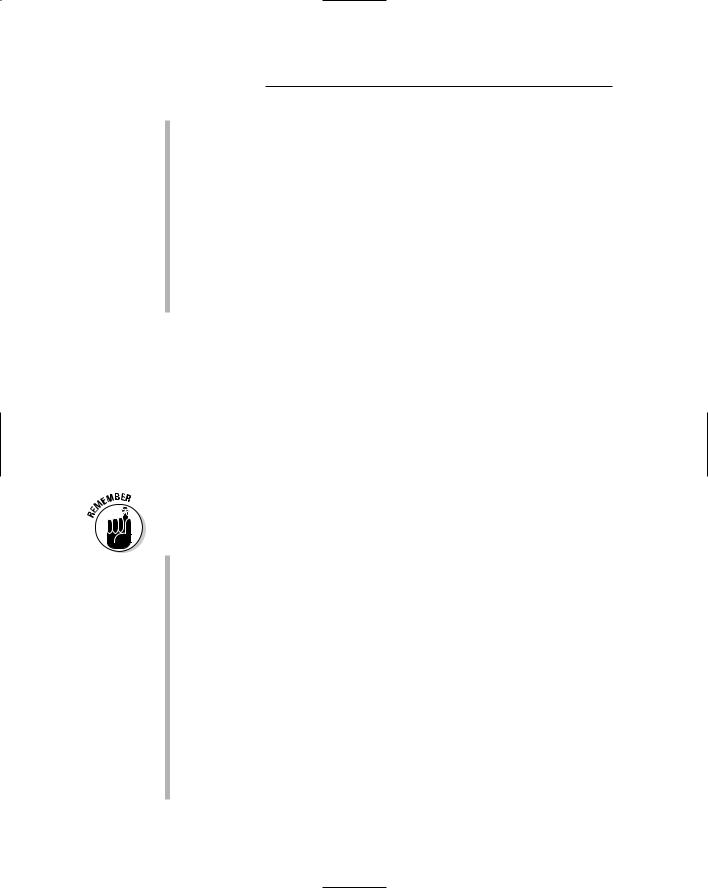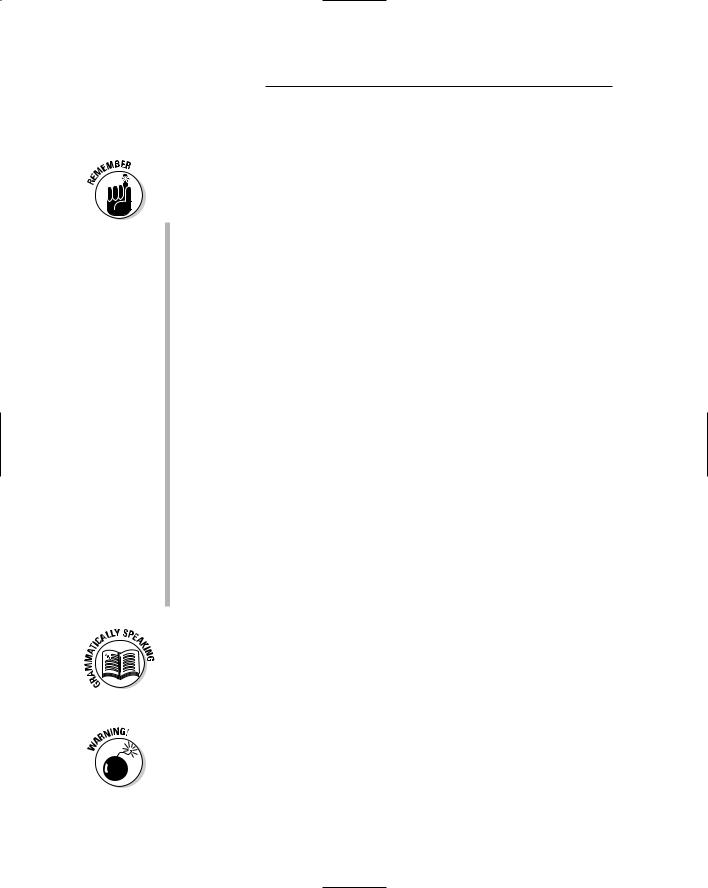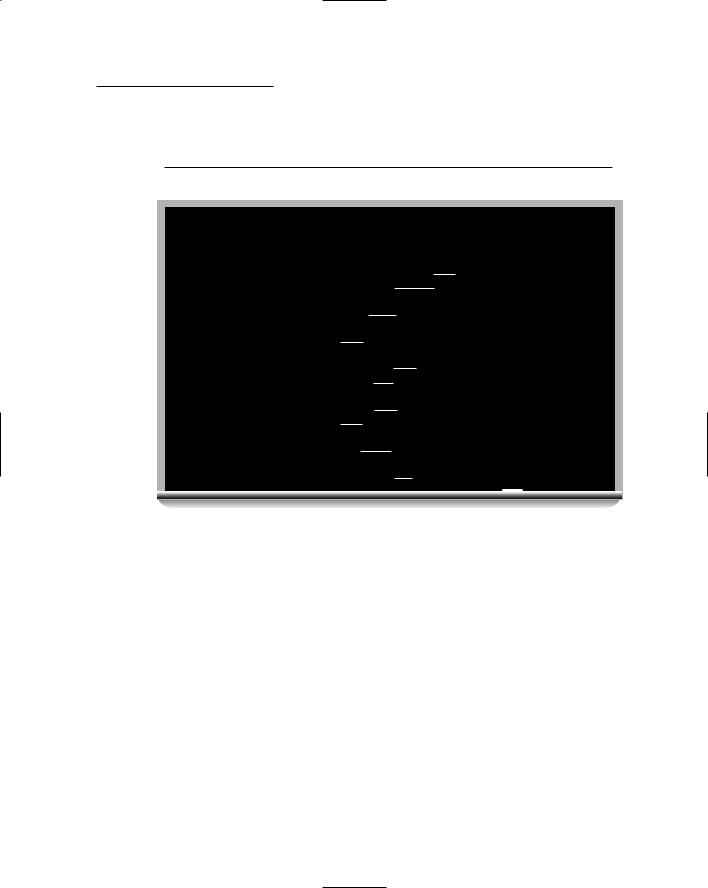
Russian For Dummies
.pdf
274 Part III: Russian on the Go
na stadion/na stadionye (nuh stuh-dee-ohn/nuh stuh-dee-oh-nee; to a stadium/at a stadium)
na stantsiyu/na stantsiye (nuh stahn-tsih-yu/nuh stahn-tsih-ee; to a station/at a station)
na syeminar/na syeminarye (nuh see-mee-nahr/nuh see-mee-nah-ree; to a seminar/at a seminar)
na urok/na urokye (nuh oo-rohk/nuh oo-roh-kee; to a class/at a class)
na vokzal/na vokzalye (nuh vahk-zahl/nuh vahk-zah-lee; to a railway station/at a railway station)
na zavod/na zavodye (nuh zuh-voht/nuh zuh-voh-dee; to a plant/at a plant)
Understanding Specific Directions
When you’re done asking for directions, it’s important to understand what you’re being told. In the following sections, you find out about prepositions and other words people use when talking about directions in Russian.
Recognizing prepositions
When people describe the location of something, they often use prepositions that you want to recognize in order to understand the directions given to you:
okolo (oh-kuh-luh; near) + a noun in the genitive case
ryadom s (rya-duhm s; next to) + a noun in the instrumental case
naprotiv (nuh-proh-teef; opposite, across from) + a noun in the genitive case
za (zah; behind, beyond) + a noun in the instrumental case
pozadi (puh-zuh-dee; behind) + a noun in the genitive case
pyered (pye-reet; in front of) + a noun in the instrumental case
myezhdu (myezh-doo; between) + a noun in the instrumental case
vnutri (vnoo-tree; inside) + a noun in the genitive case
snaruzhi (snuh-roo-zhih; outside) + a noun in the genitive case
nad (naht; above) + a noun in the instrumental case
pod (poht; below) + a noun in the instrumental case

Chapter 15: Where Is Red Square? Asking Directions 275
When you ask a simple question like Gdye muzyej? (gdye moo-zyey; Where is the museum?), you’ll likely hear a response like:
Muzyej ryadom s tyeatrom, za magazinom, myezhdu aptyekoj i pochtoj, pozadi pamyatnika, naprotiv univyermaga. (moo-zyey rya-duhm s tee-aht- ruhm, zuh muh-guh-zee-nuhm, myezh-doo uhp-tye-kuhy ee pohch-tuhy, puh-zuh-dee pah-meet-nee-kuh, nuh-proh-teef oo-nee-veer-mah-guh; The museum is next to the theater, beyond the store, between the pharmacy and the post office, behind the monument, opposite the department store.)
Note that each of the previously listed prepositions requires a different case for the noun or phrase following it. For more info on cases, see Chapter 2.
Do we really expect you to be able to juggle these cases? No, not at all. Your modest task for now is only to be able to understand the directions rather than provide them, unless of course you’re planning on moving to Russia to become a traffic police officer.
Keeping “right” and “left” straight
When people give you directions, they also often use these words:
sprava ot (sprah-vuh uht; to the right of) + a noun in the genitive case
napravo (nuh-prah-vuh; to the right)
slyeva ot (slye-vuh uht; to the left of) + a noun in the genitive case
nalyevo (nuh-lye-vuh; to the left)
na lyevoj storonye (nuh lye-vuhy stuh-rah-nye; on the left side)
na pravoj storonye (nuh prah-vahy stuh-rah-nye; on the right side)
Peter the Great’s training methods
Peter the Great, the creator of the stable Russian Army, often trained the new recruits himself. The young recruits, who were often illiterate peasants, had an extremely hard time distinguishing between the two military commands — napravo (to the right) and nalyevo (to the left). To overcome this problem, the great tsar was said to have invented a new
method of training new soldiers. He used the words the young peasants could distinguish very well: syeno (sye-nuh; hay) to indicate nalyevo (to the left), and the word soloma (sah- loh-muh; straw) to indicate napravo (to the right). And guess what? The method worked very well!

276 Part III: Russian on the Go
Here’s a short exchange that may take place between you and a friendly-look- ing Russian woman:
You: Izvinitye, gdye magazin? (eez-vee-nee-tee gdye muh-guh-zeen;
Excuse me, where is the store?)
The woman: Magazin sprava ot aptyeki. (muh-guh-zeen sprah-vuh uht uhp-tye-kee; The store is to the right of the pharmacy.)
Talkin’ the Talk
Two friends, Oleg and Sergej, are talking on the phone. It’s Saturday night and Oleg suggests that they go to a new restaurant tonight. He’s already been there and is now explaining to Sergej where the restaurant is located.
Oleg: |
Chto ty syegodnya dyelayesh’ vyechyerom? |
|
shtoh tih see-vohd-nye dye-luh-eesh’ vye-chee-ruhm? |
|
What are you doing this evening? |
Sergej: |
Nichyego. A chto? |
|
nee-chee-voh. uh shtoh? |
|
Nothing. Why? |
Oleg: |
Davaj pojdyom v etot novyj ryestoran na |
|
Pyetrogradskoj storonye. |
|
duh-vahy puhy-dyom v eh-tuht noh-vihy rees-tah- |
|
rahn nuh peet-rah-graht-skuhy stuh-rah-nye. |
|
Let’s go to this new restaurant in Petrograd side |
|
(region in St. Petersburg). |
Sergej: |
A, davaj. No ya tam yesh’yo nye byl. Gdye eto? |
|
uh, duh-vahy. noh ya tahm ee-sh’oh nye bihl. gdye |
|
eh-tuh? |
|
Oh, okay. But I haven’t been there yet. Where is it? |
Oleg: |
Ty znayesh’, gdye kinotyeatr Avrora? |
|
tih znah-eesh’, gdye kee-nuh-tee-ahtr uhv-roh-ruh? |
|
Do you know where the Aurora movie theater is? |
Sergej: |
Nu? |
|
noo? |
|
Well? |
Oleg: |
Eto nyedalyeko ot Avrory, na drugoj storonye. |
|
eh-tuh nee-duh-lee-koh uht uhv-roh-rih, nuh droo- |
|
gohy stuh-rah-nye. |
|
It’s not far from Aurora, on the other side of the street. |

|
|
Chapter 15: Where Is Red Square? Asking Directions 277 |
|
|
|
||
|
Sergej: |
Eto chto, ryadom s bulochnoj? |
|
|
|
eh-tuh shtoh, rya-duhm s boo-luhch-nuhy? |
|
|
|
Is it next to the bakery? |
|
|
Oleg: |
Da, sprava ot bulochnoj i slyeva ot aptyeki. |
|
|
|
dah, sprah-vuh aht boo-luhch-nuhy ee slye-vuh uht |
|
|
|
uhp-tye-kee. |
|
|
|
Yes, to the right of the bakery, to the left of the |
|
|
|
pharmacy. |
|
|
Sergej: |
Myezhdu bulochnoj i aptyekoj? |
|
|
|
myezh-doo boo-luhch-nuhy ee uhp-tye-kuhy? |
|
|
|
Between the bakery and the pharmacy? |
|
|
Oleg: |
Da, naprotiv bara “Vostok.” |
|
|
|
dah, nuh-proh-teef bah-ruh vahs-tohk. |
|
|
|
Yes, opposite Vostok bar. |
|
|
|
|
|
Words to Know
Ya tam yeshyo |
ya tahm ee-sh’oh |
I haven’t been |
nye byl. |
nye bihl |
there yet. |
Ty znayesh’ |
tih znah-eesh’ |
Do you know |
Nu? |
Noo? |
Well? (Go on!) |
Eto nyedalyeko ot |
eh-tuh nee-duh- |
It’s not far from |
|
lee-koh uht |
|
na drugoj storonye |
nuh droo-gohy |
on the other side |
|
stuh-rah-nye |
of the street |
Making sense of commands
Usually when somebody gives you directions, they tell you where to go, not just where something is located. For this situation, we give you several common phrases that people may use when telling you where to go. These
phrases also come in handy if you ever need to give somebody else directions.

278 Part III: Russian on the Go
The imperative mood is the form in which you hear and give directions. The imperative may also come in handy in other situations where you need to make a command or a polite request.
Here are some useful phrases in the imperative mood you may hear or want to use when giving directions:
Iditye praymo! (ee-dee-tee prya-muh; Go straight.)
Iditye nazad! (ee-dee-tee nuh-zaht; Go back.)
Iditye pryamo do . . . ! (ee-dee-tee prya-muh duh; Go as far as . . .) + the noun in the genitive case
Podojditye k . . . (puh-duhy-dee-tee k; Go up to . . .) + the noun in the dative case
Iditye po . . . (ee-dee-tee puh; Go down along . . .) + the noun in the dative case
Projditye mimo . . . (prahy-dee-tee mee-muh; Pass by . . .) + the noun in the genitive case
Povyernitye nalyevo! (puh-veer-nee-tee nuh-lye-vuh; Turn left or take a left turn.)
Povyernitye napravo! (puh-veer-nee-tee nuh-prah-vuh; Turn right or take a right turn.)
Zavyernitye za ugol! (zuh-veer-nee-tee zah-oo-guhl; Turn around the corner.)
Pyeryejditye ulitsu! (pee-reey-dee-tee oo-leet-soo; Cross the street.)
Pyeryejditye plosh’ad’! (pee-reey-dee-tee ploh-sh’uht’; Cross the square.)
Pyeryejditye chyerez dorogu! (pee-reey-dee-tee cheh-reez dah-roh-goo; Cross the street/road.)
To form the imperative when you’re talking to somebody with whom you’re on vy (vih; you; formal singular and plural) terms, such as strangers, add -tye as we did in the previous list. When you’re speaking to somebody with whom you’re on ty (tih; you; informal singular) terms, you can remove the -tye. For instance, to say “turn left” to a friend, you say Povyerni nalyevo (puh-veer- nee nuh-lye-vuh; Turn left).
Curiously enough, Russians don’t like to indicate directions with the words vostok (vahs-tohk; east), zapad (zah-puht; west), syever (sye-veer; north), and yug (yuk; south). They seem to avoid them when explaining how you can reach your place of destination. Phrases like “Go south,” “Turn west,” and “Drive south” are very rare in direction-giving.

Chapter 15: Where Is Red Square? Asking Directions 279
Talkin’ the Talk
Tom is an American graduate student who came to Russia to study Russian literature. He asks a rabotnik obsh’yezhitiya (ruh-boht- neek uhp-sh’ee-zhih-tee-ye; dorm employee) how to get to the Dostoevsky museum.
Tom: |
Skazhitye, pozhalujsta, kak mnye |
|
otsyuda popast’ v muzyej |
|
Dostoyevskogo? |
|
skuh-zhih-tee, pah-zhahl-stuh, kahk |
|
mnye aht-syu-duh pah-pahst’ v moo- |
|
zyey duhs-tah-yef-skuh-vuh? |
|
Could you please tell me how I can |
|
get to Dostoyevsky’s museum from |
|
here? |
Rabotnik obsh’yezhitiya: |
Muzyej Dostoyevskogo nakhoditsya |
|
na Kuznyechnom pyeryeulkye, nyeda- |
|
lyeko ot Kuznyechnogo rynka. Vy |
|
znayetye, gdye Kuznyechnyj rynok? |
|
moo-zyey duhs-tah-yef-skuh-vuh nuh- |
|
khoh-deet-sye nuh kooz-nyech-nuhm |
|
pee-ree-ool-kee, nee-duh-lee-koh uht |
|
kooz-nyech-nuh-vuh rihn-kuh. vih |
|
znah-ee-tee gdye kooz-nyech-nihy rih- |
|
nuhk? |
|
Dostoyevsky’s museum is located on |
|
Kuznyechnyj Lane, not far from |
|
Kuznyechnyj market. Do you know |
|
where Kuznyechnyj market is? |
Tom: |
Nyet, ya pyervyj dyen’ v |
|
Pyetyerburgye. |
|
Nyet, ya pyer-vihy dyen’ v pee-teer- |
|
boor-gee. |
|
No, it’ s my first day in St. Petersburg. |

280 Part III: Russian on the Go
Rabotnik obsh’yezhitiya: |
Vam nado vyjti na Nyevskij prospyekt |
|
i povyernut’ napravo. Iditye pryamo |
|
po Nyevskomu prospyektu, nikuda |
|
nye svorachivaya do ulitsy Marata. |
|
Tam povyernitye opyat’ napravo. |
|
Kogda dojdyotye do Kuznyechnogo |
|
pyeryeulka opyat’ povyernitye |
|
napravo. Muzyej budyet na lyevoj |
|
storonye ulitsy, na uglu ulitsy |
|
Dostoyevskogo i Kuznyechnogo |
|
pyeryeulka. |
|
vahm nah-duh vihy-tee nuh nyef- |
|
skeey prahs-pyekt ee pah-veer-noot’ |
|
nuh-prah-vuh. ee-dee-tee prya-muh |
|
pah-nyef-skuh-moo prahs-pyek-too, |
|
nee-koo-dah nee svah-rah-chee-vuh- |
|
ye dah oo-lee-tsih muh-rah-tuh. tahm |
|
puh-veer-nee-tee ah-pyat’ nuh-prah- |
|
vuh. kahg-dah dahy-dyo-tee duh |
|
kooz-nyech-nuh-vuh pee-ree-ool-kuh |
|
ah-pyat’ puh-veer-nee-tee nuh-prah- |
|
vuh. moo-zyey boo-deet nuh lye-vuhy |
|
stuh-rah-nye oo-lee-tsih, nuh oog-loo |
|
oo-lee-tsih duhs-tah-yef-skuh-vuh i |
|
kooz-nyech-nuh-vuh pee-ree-ool-kuh. |
|
You need to go out to Nevsky Avenue |
|
and turn right. Go straight along |
|
Nevsky Avenue, don’t turn anywhere |
|
until you reach Marat Street. Turn |
|
right again there. When you reach |
|
Kuznyechnyj Lane, turn right again. |
|
The museum is on the left-hand side, |
|
on the corner of Dostoyevsky Street |
|
and Kuznyechnyj Lane. |
Tom: |
Tak, znachit po Nyevskomu do ulitsy |
|
Marata, napravo i opyat’ napravo po |
|
Kuznyechnomu pyeryeulku? |
|
tahk, znah-cheet pah nyef-skuh-moo |
|
dah oo-lee-tsih muh-rah-tuh, nuh-prah- |
|
vuh ee ah-pyat’ nuh-prah-vuh pah |
|
kooz-nyech-nuh-moo pee-ree-ool-kuh? |
|
So, you’re saying along Nevsky to |
|
Marat Street, to the right and again |
|
to the right along Kuznyechnyj Lane? |

Chapter 15: Where Is Red Square? Asking Directions 281
Rabotnik obsh’yezhitiya: |
Sovyershyenno vyerno. |
|
suh-veer-sheh-nuh vyer-nuh. |
|
That’s correct. |
Words to Know
Kak mnye otsyuda |
kahk mnye aht-syu- |
How can I get |
popast’ v . . . |
duh pah-pahst’ v |
to . . . from here? |
nakhoditsya |
nuh-khoh-deet-sye |
is located |
vyjti na |
vihy-tee nuh |
go out to |
Nikuda nye |
nee-koo-dah nee |
Don’t turn |
svorachivaya |
svah-rah-chee-vuh-ye |
anywhere |
Kogda dojdyotye do |
kahg-dah dahy- |
When you reach . . . |
|
dyo-tee duh |
|
opyat’ |
ah-pyat’ |
again |
na uglu |
nuh oog-loo |
on the corner |
Describing Distances
Sometimes you don’t want detailed information about directions. You just want to know whether someplace is near or far and how long it takes to get there. In the following sections we show you some common phrases you may use or hear when asking about distances.
Marking distances by time
Imagine you’re in Moscow and you just asked a well-meaning passer-by to give you directions to Red Square. You ask a very simple question:
Skazhitye, pozhalujsta, kak mnye otsyuda popast’ na Krasnuyu plosh’yad’? (skuh-zhih-tee pah-zhahl-stuh kahk mnye aht-syoo-duh pah- pahst’ nuh krahs-noo-yu ploh-sh’iht’; Could you tell me how I can get to Red Square from here?)

282 Part III: Russian on the Go
In response to your question, the sympathetic (and very talkative) Muscovite gives you an endless barrage of street names and landmarks and direction verbs to the point that you almost feel dizzy and your exhausted mind has switched off. At this point, all you want to know is whether Red Square is far away in order to decide whether you should take a taxi or some other public transportation. So with all your remaining mental energy you ask: Eto dalyeko? (eh-tuh duh-lee-koh; Is it far away?)
In giving directions, Russians usually like to indicate distance in terms of the time it takes to get there. Outdoorsy, younger people, may say, for example:
Eto nedalyeko. Minut pyatnadtsat’ pyeshkom. (eh-tuh nee-duh-lee-koh. mee-noot peet-naht-suht peesh-kohm; It’s not far away. About fifteen minutes’ walk.)
Those people who don’t fancy walking that much may see the same distance differently and say:
Eto dalyeko. Minut pyatnadtsat’ pyeshkom. (eh-tuh duh-lee-koh. mee- noot peet-naht-suht’ peesh-kohm; It’s far. About fifteen minutes’ walk.)
You may notice that in both the previous responses, the word minut (minutes) is placed before the numeral pyatnadtsat’ (fifteen), and you may be wondering whether it’s an error. Nope, that’s not an error! Russian has a very special way of indicating approximate time, weight, distance, or even prices. Where English uses the word “about,” Russian may simply use the method of reversing the order of words, as in Minut pyatnadtsat’ pyeshkom (mee-noot peet-naht-suht’ peesh-kohm; About fifteen minutes’ walk). To be more exact, a Russian would say Pyatnadtsat’ minut pyeshkom (peet-naht-suht’ mee-noot peesh-kohm; Exactly fifteen minutes’ walk).
A very popular way of indicating the distance in Russia is by counting the number of bus, tram, trolleybus, or subway stops to the place you’re inquiring about. If you think that a fifteen-minute walk is a big deal, especially if you’re tired, you may say in response:
Eto dovol’no dalyeko. Dvye ostanovki na tramvaye/avtobusye/trolyejbusye/myetro. (eh-tuh dah-vohl’-nuh duh-lee-koh. dvye uhs-tuh-nohf-kee nuh truhm-vahy-ee/uhf-toh-boo-see/trah-lyey-boo-see/meet-roh; That’s quite far away. Two stops by the tram/bus/trolleybus/metro.)
In addition to the well-known taksi (tuhk-see; taxi), you need to know four main kinds of transportation: metro (meet-roh; metro or subway), avtobus (uhf-toh-boos; bus), trollyejbus (trah-lyey-boos; trolleybus), and tramvaj (truhm-vahy; tram). See Chapter 12 for more details on public transportation in Russia.

Chapter 15: Where Is Red Square? Asking Directions 283
Using actual measurements
Russians use the European system of measurements and define distances in terms of kilometers, meters, and centimeters. Within city limits, Russians feel more comfortable indicating distances using bus or tram stops or the time it takes one to cover the distance by walking (see the previous section); until recently, relatively few Russians had cars and most people used public transportation (which is excellent, by the way). However, when they talk about places not located within city limits, Russians usually use kilometers.
To ask a question about the distance between towns and cities, use the phrase Skol’ko kilomyetrov ot (skohl’-kuh kee-lah-myet-ruhf uht; How many kilometers is it from . . . ?) + the genitive case of the word denoting the name of the place + do (duh; to) + the genitive case of the word denoting the name of the other place. For example:
Skol’ko kilomyetrov ot Moskvy do Pyetyerburga? (skohl’-kuh kee-lah- myet-ruhf uht mahs-kvih duh pee-teer-boor-guh; How many kilometers is it from Moscow to St. Petersburg?)
Skol’ko kilomyetrov ot Kiyeva do Moskvy? (skohl’-kuh kee-luh-myet- ruhf uht kee-ee-vuh duh mahs-kvih; How many kilometers is it from Kiev to Moscow?)
To give a simple answer to the question, use numerals; we cover them in detail in Chapter 2. Just remember the following tips:
After the numeral odin (ah-deen; one) or numerals ending in odin (one), use the word kilomyetr (kee-lah-myetr), as in tridtsat’ odin kilomyetr
(treet-tsuht’ ah-deen kee-lah-myetr; thirty-one kilometers).
After the numerals dva (dvah; two), tri (tree; three), chyetyrye (chee-tih- ree; four) or numerals ending in them, use the word kilomyetra (kee-lah- myet-ruh), as in tri kilomyetra (tree kee-lah-myet-ruh; three kilometers).
After all other numerals, use the word kilomyetrov (kee-lah-myet-ruhf), as in dvadtsat’ pyat’ kilomyetrov (dvaht-suht’ pyat’ kee-lah-myet-ruhf; twenty-five kilometers).
